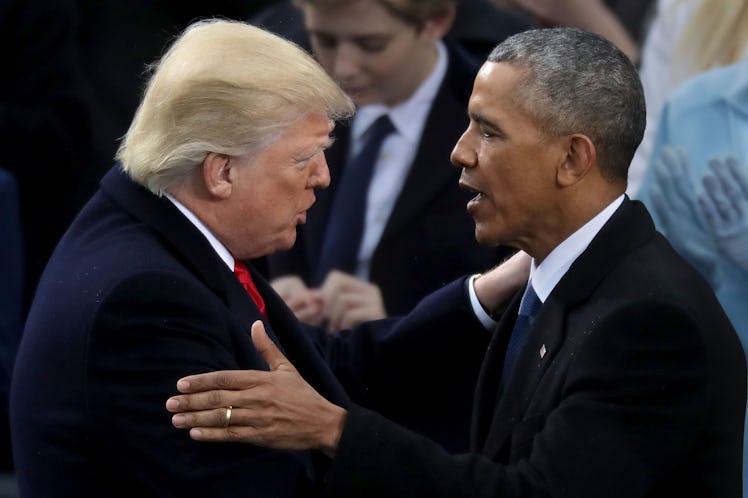
Trump & Obama’s First State Of The Unions Were Ridiculously Different
President Donald Trump delivered his first State of the Union address in a joint session of Congress on Tuesday, Jan. 30. It's the first address that this country has heard from a new president in eight years, following Barack Obama's two terms as Commander-in-Chief. So clearly, there were going to be some differences between Obama's first go around delivering the address when compared to Trump's. However, during both Obama's and Trump's first addresses, the nation found itself in trying and divided times. Trump vs. Obama's first State of the Union addresses are so inherently different, despite the fact that they both addressed the nation during trying times.
On Tuesday, Jan. 30, Trump addressed the nation, more than a year after taking office, and delivered an overall enthusiastic speech emphasizing his theme of "building a safe, strong, and proud America.” In his speech, he straightforwardly highlighted the need to unite and offer true bipartisanship in government, and pledged to work with both sides of the aisle for the wellbeing of this nation.
Trump said,
Tonight, I want to talk about what kind of future we are going to have, and what kind of nation we are going to be. All of us, together, as one team, one people, and one American family... So tonight I am extending an open hand to work with members of both parties, Democrats and Republicans, to protect our citizens, of every background, color, and creed.
Trump also took to the podium before Congress and the nation to tout the economic success and job growth that he and GOPers believe the country has seen since he took office more than a year ago. He said,
Since the election, we have created 2.4 million new jobs, including including 200,000 new jobs in manufacturing alone. Tremendous. After years and years of wage stagnation, we are finally seeing rising wages. Unemployment claims have hit a 45-year low. And something I am very proud of, African-American unemployment stands at the lowest rate ever recorded. And Hispanic-American unemployment has also reached the lowest levels in history.
Another topic that Trump addressed was foreign policy, specifically regarding the nuclear threat America faces from North Korea and Kim Jong-un's regime. In talking about North Korea, Trump openly criticized his presidential predecessors and their methods, saying:
...complacency and concessions only invite aggression and provocation. I will not repeat the mistakes of the past administrations that got us into this dangerous position.
In comparison, Obama's first State of the Union address found him in a similar partisan predicament.
Obama delivered his first address on Jan. 27, 2010. At the time, the nation was also deeply divided by partisan politics that led to stalemates in new legislature being passed in Congress. And Obama echoed the frustration that many Americans felt in his address.
He explained,
For these Americans and so many others, change has not come fast enough. Some are frustrated; some are angry. They don't understand why it seems like bad behavior on Wall Street is rewarded, but hard work on Main Street isn't, or why Washington has been unable or unwilling to solve any of our problems. They're tired of the partisanship and the shouting and the pettiness. They know we can't afford it, not now.
But unlike Trump, who praised the economic success he believes the country's seen since he's taken office in his first State of the Union, Obama was dealing with the aftermath of ending the "great recession" he inherited from his predecessor, George W. Bush's, administration. Even though Obama was criticized for his $832 billion stimulus package he passed in Feb. 2009, it was necessary to stabilize the economy — even though it would be years before it would fully re-stabilize to full strength. But rather than criticize his predecessor and throw all blame on Bush (which we've seen Trump do many a time on social media and in speeches), Obama was empathetic to the struggles Bush faced in the wake of the recession.
In the address, Obama explained,
...when I ran for president, I promised I wouldn't just do what was popular, I would do what was necessary. And if we had allowed the meltdown of the financial system, unemployment might be double what it is today....So I supported the last administration's efforts to create the financial rescue program. And when we took that program over, we made it more transparent and more accountable. And as a result, the markets are now stabilized, and we've recovered most of the money we spent on the banks.
All said and done, there was one clear difference between Obama and Trump in these two speeches: Trump spent most of his time praising himself and his administration for all of their apparent successes (whether it was directly due to Trump's policies or not), and Obama addressed the struggles his nation faced at the time and offered solutions. While Trump did address the opioid epidemic that's devastating our nation and had some mention of criminal justice reform, he failed to discuss gun violence and the ongoing, divisive race relations issues this country faces. Obama also did not throw his predecessors under the bus, which Trump happily did multiple times throughout his speech.
It's these two details that make all the difference when comparing Obama's first address to Trump's. What Trump took credit for, and what he blamed previous administrations for, is what differentiates a presidential speech from a truly presidential speech.